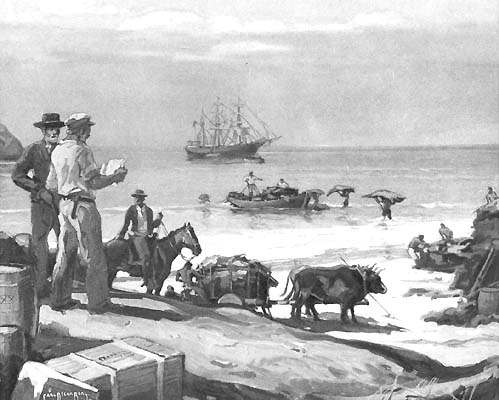 From the Journal of San Diego - USD http://www.sandiegohistory.org/journal/journal.htm
From the Journal of San Diego - USD http://www.sandiegohistory.org/journal/journal.htm
“…blessed with a climate, than which there can be no better in the world..."
- Richard Henry Dana
 The San Diego Historical Society, "http://www.sandiegohistory.org"
The San Diego Historical Society, "http://www.sandiegohistory.org" 1835
In 1935, a young Bostonian, RICHARD HENRY DANA,
arrived in San Diego as a sailor on board the Pilgrim , a ship engaged in the hide trade. As an early American observer, Dana noted San Diego 's isolation from the outside world and its dependence on the hide trade as the means of exchange for goods from foreign markets. He also noted the barren, desert-like landscape, the ruins of the former Spanish presidio which overlooked the small Mexican outpost of San Diego and the diversity of people and nationalities which the port attracted. Dana's observations about San Diego recorded during a summer spent curing hides later formed the basis for a book about his travels,
Two Years Before the Mast . Of the many impressions recorded by Dana during his stay in San Diego , two found expression time and again in his writings -- the area's near-perfect climate and bay. Although Dana could not have envisioned the city we know today, he quickly recognized the region's natural advantages -- advantages that would be echoed by others who would use the bay and climate to promote San Diego for the next 150 years.
March 27, 1850
An Act to Incorporate the CITY OF SAN DIEGO is passed. First election establishes government by a Common Council and elected mayor. San Diego 's first Mayor is
Joshua Bean , brother of the famous Judge Roy Bean
In 1850, San Diego's population numbered about 650. New arrivals were hoping to transform this former Mexican community into a thriving commercial center. Frame buildings replaced adobe structures and English replaced Spanish as the town's common language.
1867
ALONZO HORTONarrived from San Francisco in 1867. Horton's enthusiasm, salesmanship and marketing skills sold lots, brought residents and business to his New Town and established his reputation as the city's first truly successful real estate developer.
As New Town began to take shape, Horton's concerns turned to promotion of the city to newcomers. Believing in favorable first impressions, Horton encouraged residents to plant gardens and orchards and to keep their homes and businesses painted and in good repair. Early civic improvements included planting trees along main streets, construction of a large wharf and elegant hotel to greet new arrivals, theater and courthouse.
Return to Timeline


